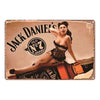With the motif of a sexy pin-up on a bottle of Jack Daniel's, this sublime Metal Deco Whiskey Plaque will bring charm and celebration to your decoration!
- ⚡ WITH THE PURCHASE OF TWO VINTAGE METAL PLATES, THE 3RD IS FREE! ⚡
- Materials :
- Metal protected against corrosion , built to last .
- Very light and easy to install.
- Carefully packaged and placed in a shock-resistant package for safe transport .
- Size : 20 (W) × 30 (L) cm / 30 (W) × 40 (L) cm.
- FREE SECURE DELIVERY & SHIPPED WITHIN 48/72 HOURS (see our FAQs ).
Description of this Whiskey Decorative Metal Sign
Considered America's most famous whiskey, Jack Daniel's 150-year history dates back to 1866 when the first distillery opened. It was the first recorded distillery in the United States, founded by Jasper Newton Daniel, who also served as the first master distiller.
In 1904, with the brand's growth, the Old No. 7 earned a gold medal at the World's Fair - the first of seven gold medals it has won to date.
The journey began when young Jack was taken in by a local preacher named Dan Call after running away from his father's house because he despised his stepmother.
Until recently, the story was that methylated spirit distiller, Call, taught his young apprentice, Jack, how to run his Tennessee distillery, but it turns out he's one of the slaves of Call, Nearis Green, who had passed on his distilling experience to Daniel.
Uncle Nearest is the best whiskey maker I know," Call was quoted as saying in a 1967 biography, Jack Daniel's Legacy.
Green's key role in advising Jack Daniel had previously been suspected but, like that of many slaves, his contribution to the development of American whiskeys was never recorded.
Phil Epps, global brand director of Jack Daniel's at Brown-Forman, which has owned the distillery for 60 years, insists it was not a "conscious decision" to omit the Greens from whiskey history.
According to Epps, they came across the founder's story while researching the origin of whiskey.
As we dug into it, we realized it was something we could be proud of,” Epps said.
A man believed to be Nearis Green's son sits next to Jack Daniel in this photo taken in the late 1800s.
1875 Jack established a registered distilling business with Call using money from his late father's estate. Shortly after, Call left the company for religious reasons, and Jack became its owner.
In 1884, Jack Daniel purchased the land where the distillery stands today and ran the business until 1907, when he passed the reins to his nephew, Lemuel "Lew" Motlow, since he had not never married or had children.
Motlow ran the distillery for 40 years. The business suffered from Prohibition passed in 1910, making distilling Jack Daniel's illegal in Tennessee.
Motlow challenged the law in a case that went all the way to the Tennessee Supreme Court, but when it was unsuccessful, the company moved production to St. Louis, Mo., and Birmingham, Alabama, but was unable to achieve the quality of whiskey that was being produced in Tennessee.
Missouri and Alabama also underwent similar bans, leading to several years of repeals and changes to the law, before the distillery was finally operational in 1947.
With World War II reaching its height, the distillery ceased production in order to redirect its resources to the war effort.
It was Frank Bobo, the head distiller between 1966 and 1988, who transformed Jack Daniel's from a local sipping whiskey in the American South to a world-famous whiskey, with Old No. 7 also being synonymous with rock and roll music than the electric guitar.
With New York clubs hosting the biggest names in rock and roll, and Jack Daniel's partnering with most of these events, the drink's popularity has only grown.
Jeff Arnett is currently the head distiller at Jack Daniel's and under his leadership the brand has experienced the greatest expansion in its history, introducing its first flavored expression, Jack Daniel's Tennessee Honey and Jack Daniel's Fire four years later.




 Free delivery
Free delivery
 Don't hang around! Nothing remains but
Don't hang around! Nothing remains but 



